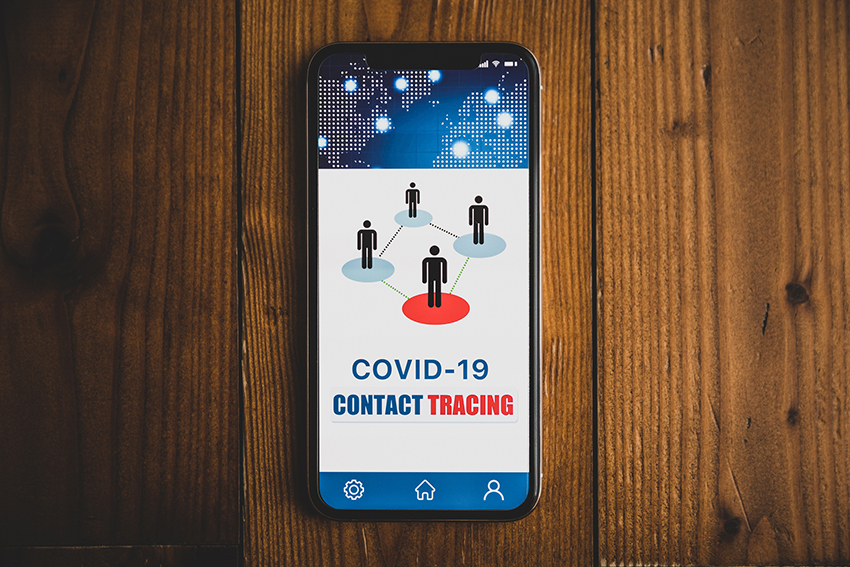
As the world grapples with COVID-19, experts are calling for better identification and isolation of new cases. These tasks can be scaled up with the use of technology. Digital contact tracing can accelerate identifying newly diagnosed patients, instantly informing past contacts about their risk of infection and supporting social distancing efforts. Geolocation data can be used to enforce quarantine measures. Social media data can be used to predict outbreak clusters and trace the spread of misinformation online.
However, using technology for early case identification at the population level presents multiple ethical challenges. As such, the following ten factors should be carefully considered1:
- Testing. For digital contact tracing to work, there needs to be enough COVID-19 tests for anyone who believes they are positive. Contact-tracing apps rely on users to report if they were tested positive. The apps, then, can use Bluetooth to find all the other phones that were in contact with the virus carrier and notify them. Cryptography ensures that the apps cannot identify individuals on either end.
- Aggregated vs. identifiable data. There are several ways in which population mobility data can be collected: (1) anonymized location pings that map mobile density to understand compliance with social distancing; (2) tracking location and movements of devices anonymized into broad patterns and providing estimates of aggregate flows of people; (3) privacy-sensitive location tracking on an individual level relying on users to share their location history when they test positive. Users that came close to that phone receive notification of their risk of infection and are advised to self-isolate. Location data is stored on individual phones and is only shared with third-party users when users test positive. Notifications about the risk of infection are de-identified; (4) government-led efforts that trace individual movements and release information on those who test positive. An ethical alternative to the latter is a third-party contact-tracing app freely downloaded by users who give their consent to location tracing and disclosure of information in a privacy-sensitive manner. Any use of location tracing should come with safeguards to ensure the data is not retained or used for any other purposes than epidemic containment. Access and use of data should be limited and highly regulated.
- Voluntary consent. There might be several issues in implementing consent procedures such as language barriers, lack of comprehension, and absence of choice. Voluntariness needs to be preserved on each step of digital contact tracing implementation: decisions to carry a smartphone, download contact-tracing app, leave the app operating at the background, react to its alerts, and share contact logs when testing positive for COVID-19.
- Privacy risks. Maximum effort should be undertaken to protect the privacy of diagnosed people. Publicly available data should be limited to protect identities. Users should consent to sharing their location data, and the involvement of third-party entities in the data sharing process should be limited or eliminated. Whenever possible, collected data should stay local to participants’ devices and, if the system uses identifiers, they should not be linked to other identifiable information.
- Transparency in implementation, including a transparent/auditable algorithm. Public officials need to disclose their reasons for implementing a contact-tracing intervention and safeguards built into this intervention. Algorithms that will operationalize any case identification intervention should be open to public scrutiny to ensure fairness, accuracy, and absence of bias. Similarly, an app should be developed using an open-source approach, enabling independent experts and media to access and evaluate the source code.
- Data security. There is a need for multiple protections against data loss and unauthorized access. Effective database management, including encryption and automated backup procedures, needs to be implemented. Storing only anonymized and aggregated data and limiting data storage to the time when a person can be contagious is a way to protect data security.
- Governance. Given numerous historical examples of abuse of vulnerable individuals in the name of the public good, officials planning to implement a mobile case identification need to assemble a diverse advisory board to provide oversight. Civil liberties advocates and various public voices need to be involved in determining data uses, collection, and resulting interventions. This governing body should provide updates on the impact of digital contact tracing (e.g., number of app installations, number of self-isolations, or contacts with health professionals). These updates will further promote the adoption of contact-tracing tools by giving people a sense of whether these tools are effective. The governing body should also identify measures to phase out digital contact tracing.
- Assurance of equitable access to treatment and absence of stigma. It is essential to guide the implementation of digital contact tracing approaches in a way that reduces stigma. Efforts to curb the epidemic should not turn people’s mobile phones into a digital version of the medieval leper bell. For instance, instead of local authorities enforcing isolation, these tools might allow health professionals to alert quarantine-breakers of the risk. Additionally, access to treatment should not be conditioned on the use of the app or data gleaned from the app.
- Opt-in vs. opt-out enrollment. Several nations that implemented mobile case identification approaches have chosen various implementation strategies. In China, the enrollment was voluntary, but the system was set up in such a way that participation was essential to perform daily functions.2 In Israel, the recipients of governmental notifications had not signed up for the tracking system, and they could not opt-out.3 In Singapore, participation was voluntary, with a moderate level of uptake from citizens. States planning to adopt digital contact tracing need to consider opt-in enrollment that would preserve individual autonomy.4
- Efforts to include vulnerable groups. Uptake of a mobile app will be limited among the most vulnerable groups—elderly, homeless, and economically disadvantaged. Additionally, 21.6% of the US population are non-English speakers and about 10 million are undocumented immigrants.5,6 The mobile intervention may not reach vulnerable groups if they have no access to mobile phones, if they cannot navigate an app interface due to language or tech literacy, or if they are worried about the security of their private data. Efforts to implement digital contact-tracing should go hand in hand with determining which groups are likely to be excluded or misrepresented by these tools.
Author Bio:

Alex Dubov, PhD
Dr. Dubov is an Associate Professor for the School of Behavioral Health. His research interests lie in applying scientifically rigorous approaches (i.e. conjoint analysis) to better understand and improve both patient and physician decision making. He is also interested in leveraging emerging technologies as innovative approaches for supporting the implementation of combination (biomedical, behavioral, health system) interventions to prevent HIV infection among groups that are epidemiologically at high-risk for infection and whose prevention needs are complicated by their socially marginalized statuses in their communities.
References:
- Dubov, Alex, and Steven Shoptaw. 2020. "The value and ethics of using technology to contain the COVID-19 epidemic." The American Journal of Bioethics 20.7: W7-W11
- Parker, Michael J., et al. 2020. "Ethics of instantaneous contact tracing using mobile phone apps in the control of the COVID-19 pandemic." Journal of Medical Ethics 46.7: 427-43
- Halbfinger, D., I.Kershner, and R.Bergman. 2020. “To track coronavirus, Israel moves to tap secret trove of cellphone data. New York Times. https://www.nytimes.com/2020/03/16/world/middleeast/israel-coronavirus-cellphone-tracking.html.
- Kupferschmidt, K. 2020. “The lockdown worked – but what comes next?” Science 368(6488): 218–219.
- Mizoguchi, N. , L.Walker, E.Trevelyan, and B.Ahmed . 2019. The older foreign-born population in the United States: 2012–2016. United States Census Bureau.
- Fazel-Zarandi, M. M. , J. S.Feinstein, and E. H.Kaplan . 2018. The number of undocumented immigrants in the United States: Estimates based on demographic modeling with data from 1990 to 2016. PLOS One 13(9): e0201193.
